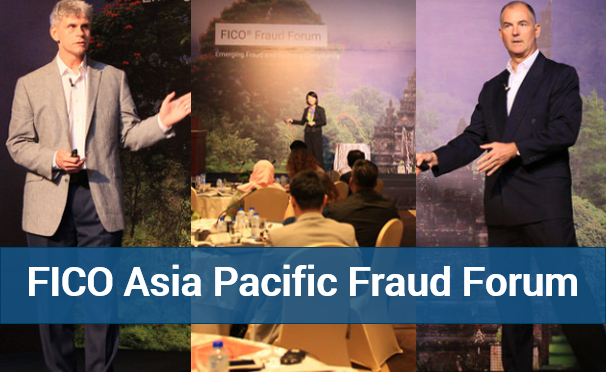Banking Fraud – What’s Happening In Asia Pacific?
Blog: Enterprise Decision Management Blog

FICO recently hosted 60 banking fraud professionals from 33 organizations and 8 countries at its Asia Pacific Fraud Forum. Attendees were keenly interested in how artificial intelligence and machine learning continues to be a key technology in the fight against fraud and financial crime. There was also a lot of discussion about the growing convergence between fraud and compliance departments and how business and operational models must adapt. Lastly, there were common challenges around the growing complexity of data sets and the need to deal with them at speed and with greater accuracy.
Three of FICO’s fraud leads explain some of the key themes and discussion points raised at our Asia Pacific event.

Banking Fraud – Financial Crime Convergence!
Adam Davies: During the event, there were many conversations and discussions around the convergence between fraud and financial crime. It was interesting to see that many of the attendees had responsibilities that covered multiple risk disciplines. Increasingly, there are many synergies between what even been separate functions.
For example, the need to align KYC (know your customer) and application fraud controls, better leverage third-party authentication data to mitigate account take-over and manage future eKYC controls. We also heard from clients that they wanted to drive better economies of scale by leveraging a common technology platforms to ingest, orchestrate, enrich and score transactional data for both fraud and AML decisioning.
What was clear, is that there are lessons learn from fraud, that could benefit AML teams. Namely, the transition from an intensive manual approach using highly skilled individuals to investigate cases based on risk profiles, to one that embraces an analytically data-driven approach to find the needles in the haystack. We heard numerous clients say they are adding more and more FTE to manage the increasing volumes of potential money laundering cases but that they are still having to deal with high levels of false positives (which was the case in fraud management before the widespread use of machine learning approaches to address fraud).
Banking Fraud – The Need for Speed
Adam Davies: Another common theme at the conference was the need for speed in fraud monitoring. With the rapid introduction of faster payments, mobile P2P money movement and a drive towards open banking; modern fraud management can only really be done in real-time.
While managing real-time fraud in cards has been the best practice approach for more than a decade, attendees discussed how to manage fraud at the customer or enterprise level in real-time. How do we make the right decision at the right time and balance the customer’s experience across product and channels? While at the same time deploy countermeasures to prevent the all too common account/customer take over?
The challenge extends further, customers expect to be able to open new accounts or add new products/services with low friction and quick acceptance and if fraud is suspected they expect to be contacted quickly through their favourite channel and for the incident to be resolved quickly. Certainly, a tall order for every fraud professional, but it was great to see the dialogue and ideas that were shared by both presenters and delegates as they have embarked on the high-speed journey.

Banking Fraud – Card Not Present, The Key Vector
Raed Taji: Card Not Present (CNP) fraud remains APAC’s number one fraud type in terms of losses. It now accounts for between 85 and 95 percent of all card frauds within the region. Scott Zoldi, our Chief Analytics Officer, delivered a presentation that was extremely insightful as to how FICO has been enhancing its predictive models to address this persistent industry trend.
Using an extensive foundation of global fraud and non-fraud transaction data, FICO is able to develop new machine learning models to tackle CNP. These improvements can benefit fraud operations in two distinct ways. One is to reduce the overall fraud losses and the other is to identify fraudulent CNP transactions with greater accuracy. These innovations when added to more efficient strategy formulations and more effective operational processes will help organizations meet their fraud management goals. Ideally, striking the perfect balance between mitigating fraud risk, improving the customer experience and maximizing revenue potential.
Banking Fraud – So Much Data to Bring Together
Raed Taji: Increasingly, fraud decisions have to made in a multilayered way, where clients increasingly have to bring together various third-party data and intelligence and combine it with their own data. During the conference, there were fascinating insights from various countries about the types of data fraud professionals are using to manage authentication and account access risk.
What was clear is that there are very interesting vectors/insights that can be gained when these data assets are used. Examples included data generated by smartphones, geolocation data, email risk, biometrics and more. We learnt that in China their access to data is quite extensive, which has provided a broad range of data points to help predict higher levels of risk. For example, fraud professionals have found that the number of financial applications installed on a mobile phone and even the type of vehicle you drive can have a strong predictive power in spotting new account fraud. This trend is set to increase, with new companies regularly entering the market place and looking to innovate. Financial crime and fraud teams are going to need to think about how to best procure and orchestrate data at the right price, with the right lift in fraud detection, while not drowning in data.

Americas Fraud, Security and Compliance
Fair Isaac Advisors
Banking Fraud – Business and Operations Must Catch Up to Technology
Drew Manuel: The forum highlighted that not only has the technology and analytics evolved quite rapidly over the years, but attendees have also realized that their business and operational model must also develop. The current siloed and product-centric approach to managing fraud and compliance was debated heavily. It was clear that most felt that an enterprise-wide structure was needed to address all financial crimes. It’s easy to adopt new technologies and analytics, but changing an operational business model can be more challenging, requiring agreement from many different units.
Securing agreement from critical unit leaders is just the first step, the training and execution of the plan becomes the more challenging step. Fair Isaac Advisors provided different approaches to the attendees around how they can advance their organizational structure. Simply put, one must not forget that adoption of new platform solutions and analytics will also require operational changes to your organization.
Below is a video snapshot of the 2018 Asia Pacific Fraud forum held in Bali over two days in October.
If you want more information about the sessions at 2018 Asia Pacific Fraud Forum, drop us an email at: infoasia@fico.com
The post Banking Fraud – What’s Happening In Asia Pacific? appeared first on FICO.
Leave a Comment
You must be logged in to post a comment.








